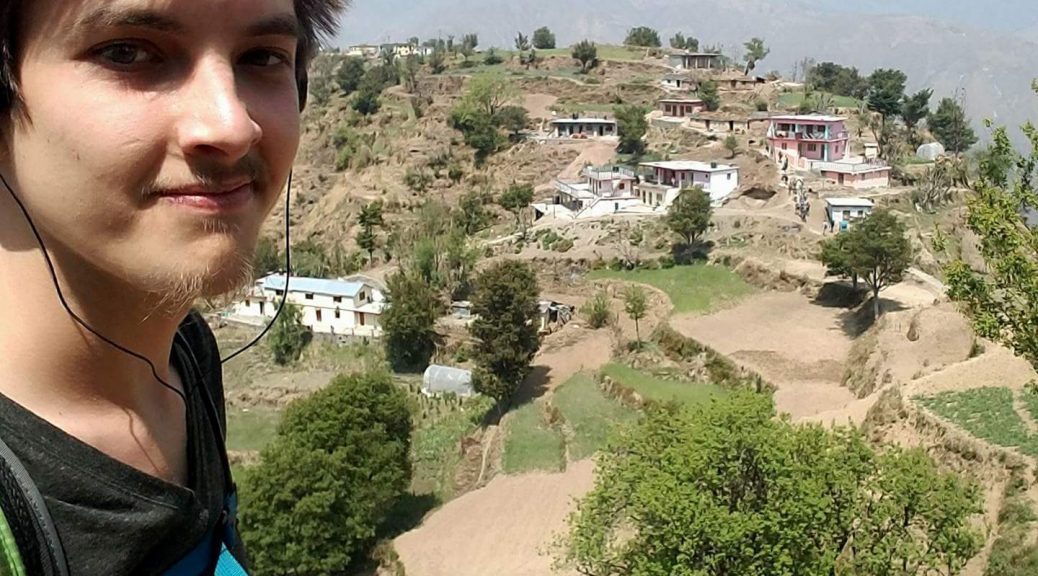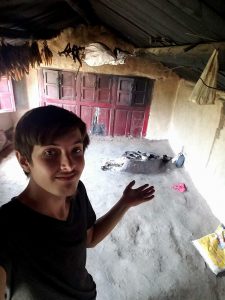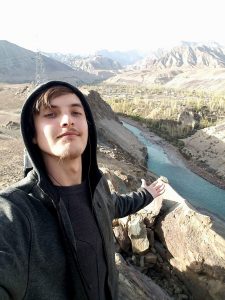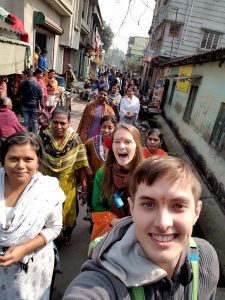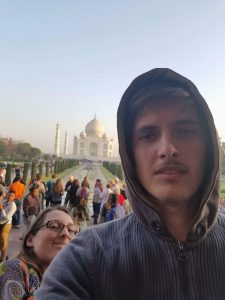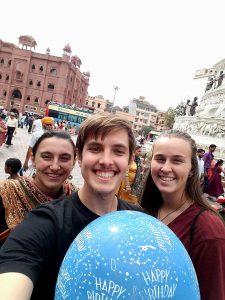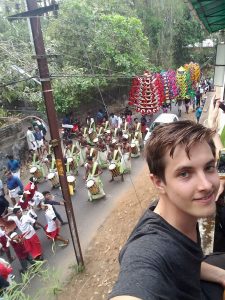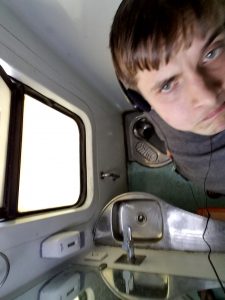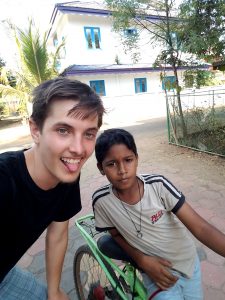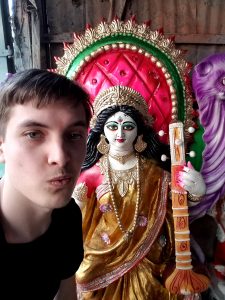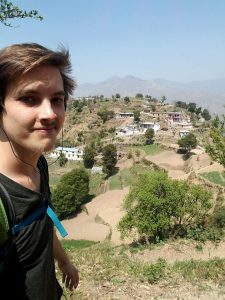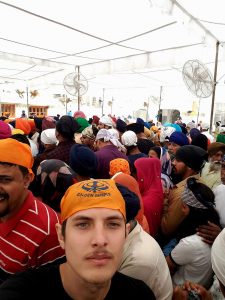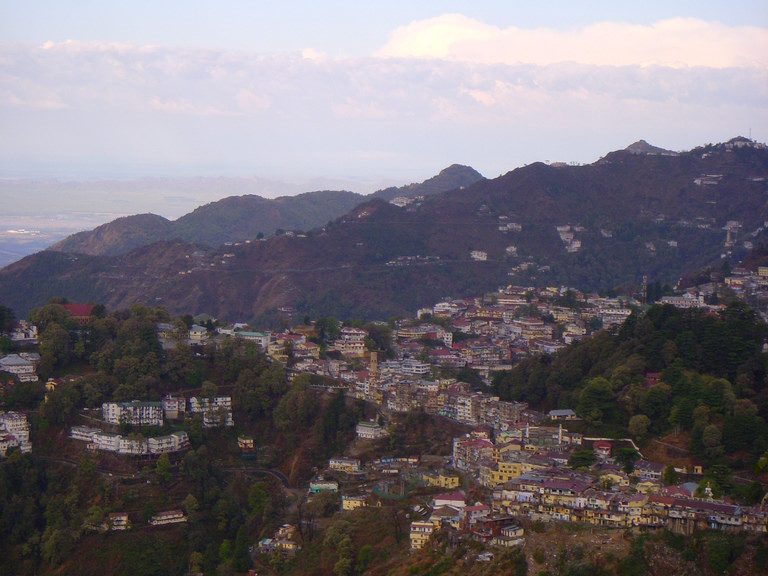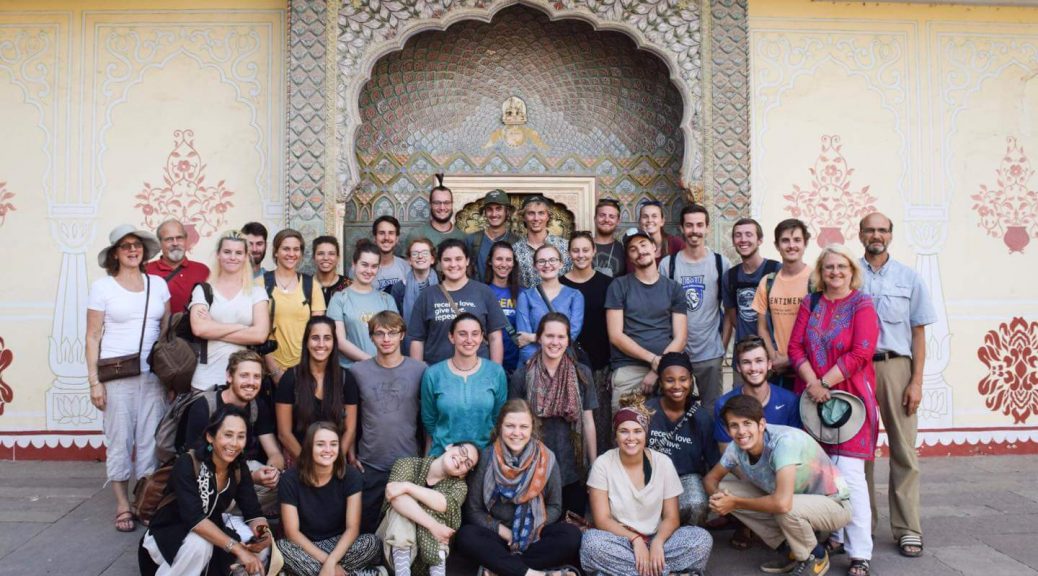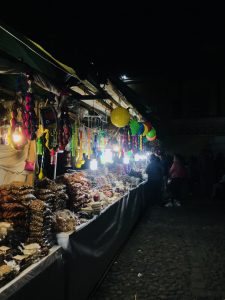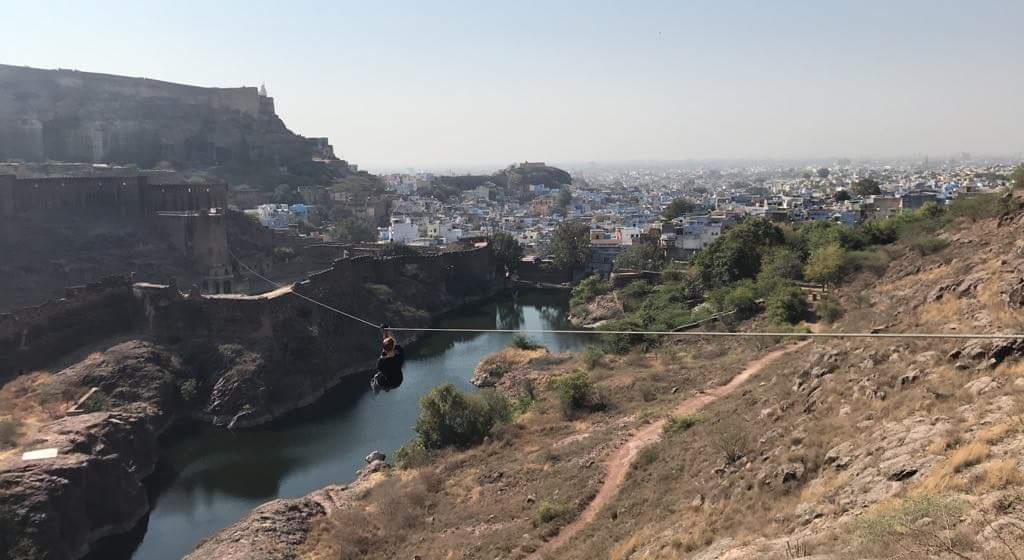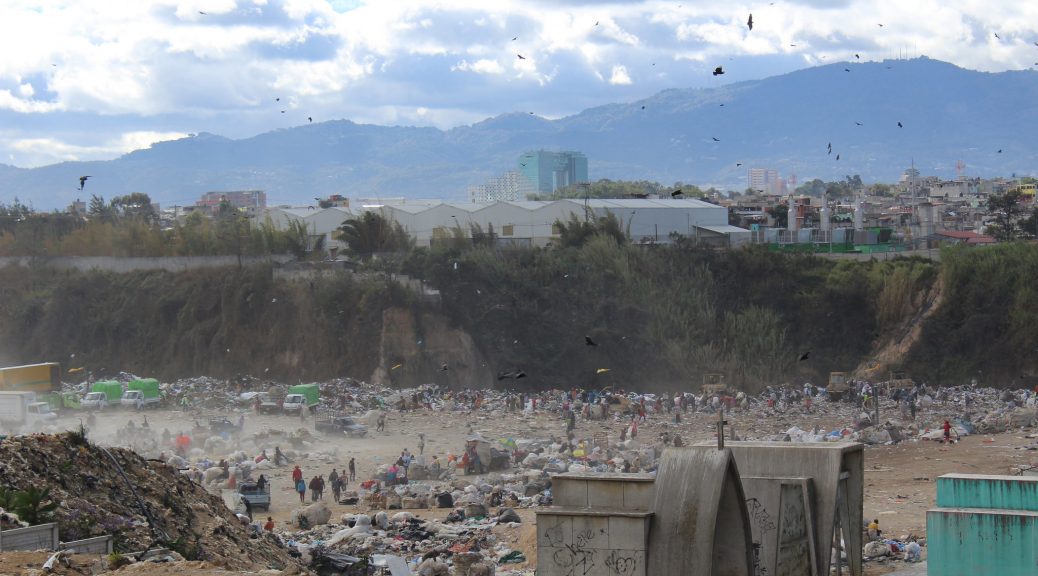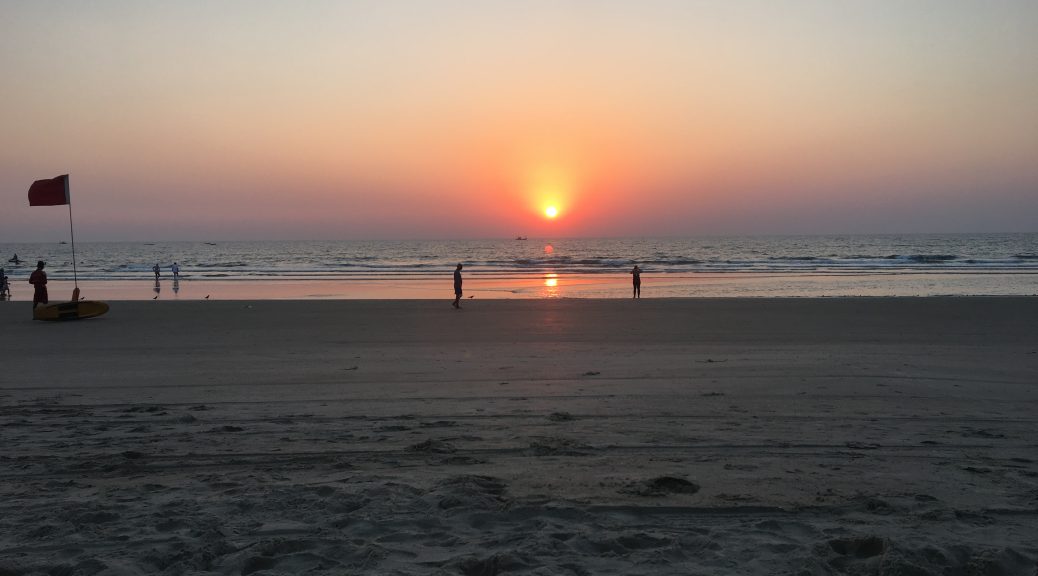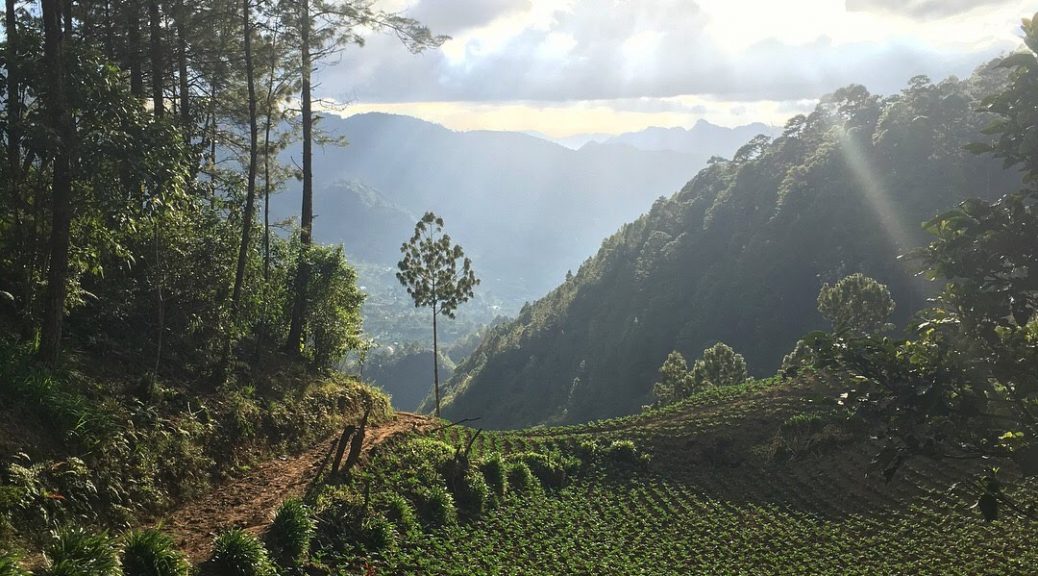Tag Archives: featured
India: Mussoorie, elevation 6,580 feet
Mussoorie Impressions
Mussoorie has carried with it more anticipation than any other stop on this trip for me. Although I enjoyed our racing around Rajasthan for two weeks, my mind and body were exhausted and looking forward to resting in one place for some time. As we boarded our third and final overnight train ride, I couldn’t help but picture vast expanses of the Himalayas, and nestled right in the middle of all the grandeur, Mussoorie.
The train itself brought with it some challenges. My nose was assaulted with the scent that only sitting directly next to a bathroom can provide. My bed was chronically slanted towards the wall, subtle enough that it was unnoticeable when I was sitting up or pressed against the wall, but extreme enough that I would slide back into the wall whenever I eventually forgot about my situation and rolled over. However, even though it may have been grimy and uncomfortable, I knew in that moment having a bed and roof over my head with a guaranteed breakfast in the morning was more than mass amounts of people could say – a thought that has been ever present on my conscience since arriving back in January.
After a long night of restless sleep and a lot of skidding into the wall, I was greeted with the alarm of our tour guide, Tsering, running up and down the halls playing “Country Roads” by John Denver and singing along very loudly, only stopping to surrender into laughter and tell us to wake up. As is custom in India, the train was delayed 40 minutes, giving us time to relax and watch the country go by. Time passed quickly and we were soon shepherded across the road from the station into five vans, which carried us through manic traffic until we were soon on our way up the long, winding, steep roads into Mussoorie.
Upon arrival, we were greeted at Doma’s Inn – owned by our tour guides, the Nima’s – which did not disappoint. The inn was anything but bland. Outside was primarily bright red with streaks of blue and yellow, not much changed on the inside. We immediately began exploring and understanding the pristine landscape we would be able to call home for the next two and a half weeks. I was ecstatic because I, as well as many of our group, thrive when surrounded by mountains. Being drawn to its beauty, adventure, and challenge, I’ve
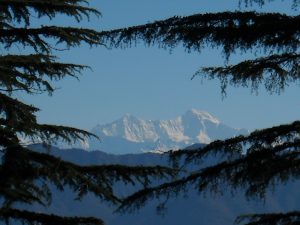
had a fascination and desire to visit this mountain range since early elementary school. Downtown Mussoorie was a stone’s throw away, but we learned quickly that going anywhere meant negotiating long, steep hills. Battling exhaustion but fueled by curiosity, we soon saw shops lined one after another ranging from shoemakers, hair stylists, fabric benders, restaurants, and many more! After climbing into bed, exhausted from a combination of walking and altitude, I quickly fell asleep. We then began a routine of breakfast at 8, Hindi lessons from 9-11, and our cross-cultural class from 11:30-12:30. With afternoons absent of classes, they ranged from total freedom to different excursions, such as guided hikes and tours from Tashi and Tsering.
-Seth Weaver
Rafting
Our rafting adventure was broken into two days. The first day we had a safety briefing and went over basic rescue techniques with our instructors. We had a rather lazy day only navigating one technical class 4 rapid called “the Wall.” We had a few opportunities to jump into the Ganges River and float around. It was very cold, coming down from the Himalayas. After a few minutes, when your body goes completely numb, it becomes much easier to enjoy the beautiful surroundings. For the most part, everyone was nervous to go swimming. At the end of our first day we played the paddle game – a game where everybody stands in a circle with a paddle. The leader calls out “left” or “right,” and you have to grab the paddle beside you before it hits the ground. As people get eliminated the increasing gap moves and it is harder to get to the next paddle. We had a fantastic day on the river and I am sure most of us were wiped.
The second day was packed with much more action. We went through a lot more rapids, some of which were named “Return to Sender,” “Roller Coaster,” and “Golf Course.” While navigating one of the class 3 rapids, our instructor told us to jump out and go swimming. I was a little shocked at first when Ben and Aaron first jumped and decided to jump out myself. The water was very turbulent and powerful. It was exciting and even a little scary being thrashed around so violently in the whitewater. Later, we got an opportunity to do a little cliff jumping. The rafting trip was a ton of fun and we got to do things that would not have gone over well in the States. Rafting will surely be one of the more memorable parts of the trip.
– Alex Navari and Cody Trumbo
A poem
Perched on the counter,
as there’s no chairs,
my sticky fingers slather
Prakesh’s bread with jam.
Monkeys terrorize as I
watch unconcerned, yet,
take up my new friend:
A large, thick stick.
– Caroline Gehman
Children oh children
How I adore your adventurous spirits
and your devotion.
How your innocence and energy radiate.
A three hour trek both to and fro, just to gain
knowledge and growth in not only
academic studies, but in character.
Children oh children
How I adore your enthusiasm
and your strife.
Children oh children
Never let that spark in your souls die.
– Sophie Hartman
inspired by a visit to Kaplani School and Kolti village in Mussoorie
India: Rajasthan to Mussoorie
Dawn in Mandawa
Location: Roof of a Haveli in Mandawa, Rajasthan, India. 6:15 am.
The sound of music drifts through the brisk March air towards me from some unknown source. The city seems still and sleepy. Occasionally, I catch the moo of a cow and the chirp of a bird. Audible all around me is the sound of street cleaners with their handheld straw brooms as they push large clouds of dust and piles of trash.
The sun rises slowly from behind a layer of thick haze in the distance. The haze causes the sun to cast a gradient of pinks, reds, and oranges onto the sky. Slowly, the city awakens. The sound of distant horns begins first, slowly increasing to shatter the stillness with their harshness. People are visible now in the streets, leaving their shops and homes to begin their day under the pale orange light.
All around me, I see a mass of temples, havelis, and buildings in various states of disrepair. The honk of horns increases still, now interposed by humorous jingles. A bus rumbles slowly down the narrow street, struggling to turn the sharp curve of the road as a stream of motorcycles and mopeds pass it on either side. The sun has arisen and in response, the city has awaken.
-Brandon Chupp
Squeals on Wheels
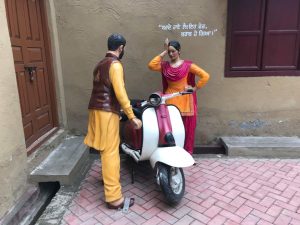 India is well known for its hectic traffic and rightfully so. My scariest experience on wheels, however, did not occur on the roads of India. It happened while being pushed around in a wheelchair at a simulation of a Punjabi village.
India is well known for its hectic traffic and rightfully so. My scariest experience on wheels, however, did not occur on the roads of India. It happened while being pushed around in a wheelchair at a simulation of a Punjabi village.
Train stations create an environment in which you need to stay alert; it seems anything can happen in the chaos. With 32 students, the shuffle from the train to our next mode of transportation adds to the discombobulation. As we rushed through the station after a long train ride, around 9pm, fatigue from a bug being passed around drained my energy to a critically low level. I struggled to put one foot in front of the other and could barely see over my backpack. We approached a curb and I sadly did not see the piece of gravel that my foot was about to land on. Little did I know that my next step would impact the rest of my trip.
My ankle bent at an unnatural angle as the extra weight on my front and back made me unable to recover as I normally would. I saw spots and did not know how I would make it to the bus. The next 20 minutes are a blur. I remember fighting off a desire to pass out and drift into a world of sleep where I could ignore the pain. I told myself, you’re just tired you’ll be better in a few days, but, a few days later, I found myself being pushed around in a wheelchair by a maniac, Yelisey Shapovalov. The name still sends the sensation of falling surging through my gut. As we explored the “authentic Punjabi experience,” the claim still causes skepticism, I was pushed up hills, where my caretaker would let go just long enough to cause panic. My wheelchair, with me still in it, was picked up and carried over curbs. By the end of the trip, I was convinced I would teeter off either the edge of the wheelchair or my sanity. Fortunately, Yelisey only wanted to incite trepidation and not true fear. We watched the acrobats, dancers, and warriors twirl in the grass, dazzling us with their heritage. I longed to have the physical health to move as they did. Despite my ankle and the frustration it brought, I made it through Sadda Pind as intact as I arrived and enjoyed the spectacles of the “authentic Punjabi experience.”
-Allie Sawyer
Arriving in Mussoorie
I had anticipated our time in Mussoorie since the start of our travels and the day had finally come. Mussoorie is situated in the Himalayan foothills at about 6,600 feet. The ride up to Mussoorie was wild! We climbed on winding roads for about an hour and as we got higher the roads got narrower and steeper. As we drove up, we could see the city of Mussoorie built into the mountainside. I was in constant awe of the view and atmosphere. 
We eventually got to Doma’s Inn which is owned by our guides family. The Inn is quite colorful and represents or guides well. It is small but unique in many ways, and includes a sweet view down to the slopes below Mussoorie. After getting situated here, a group of us took a walk. This was a cool loop that gave us views of the surrounding peaks and valleys. The walk gave us a better understanding of how steep the roads are in Mussoorie. We were able to see tall evergreen trees, monkeys and some small shops. Unfortunately, it was hazy and so we could not see the Himalayas. Even with this being the case, I continually said “unbelievable” on the walk. It is exciting to have finally arrived in Mussoorie. This is the place where our leaders lived and/or grew up in, and we are eager to have them share their home city with us. I look forward to understanding the culture here as well as going on hikes to try and see the Himalayas.
-Trevor Oyer
Tired
Cafe Coffee Day
Mudcup Cafe
Ivy Cafe
I do not mind walking for coffee
and finding shops within the clouds of trees
and sweating in the cold. All for coffee.
I say to myself, just Keep going.
Natives with impressive lungs pass me breathing
steadily, but I have to stop moving.
With struggling breath I look down and see
tiny specks that I know are bigger than me.
Do I really need coffee?
My energy level says yes,
but my unmoving feet know best.
-Jasmine Miller
India: Rajasthan, Part II
El Classico, or A Day in Jaipur
An account of perhaps the most comically representative full-day experience of our entire trip. It all began with a man wearing a straw hat and a winning smile who stepped onto our bus that morning and invaded our lives forever. “Goodmorningmynameis[incomprehensible]butyoucancallmeJiJi––” he said breathlessly. “It’s a good thing you have me, because I’m the best tour guide in Jaipur! Here are the things Jiji will show you today.” [Winning smile] Emerson and I looked at each other – it was clear this day was going to be something special.
 An endless stream of burbling chatter from Jiji kept us entertained (“I would be a perfect human being, except I’m a couple inches too short – look, there’s a lake!”) until we pulled up at the Amber Fort ante-parking lot, which is kind of like an antechamber except less like a waiting room and more like a holding tank for tourists. “Jiji.com!”* said Jiji cheerfully. “Also, we aren’t actually at the fort yet, so we need to use jeeps to get there. There’s plenty of room!” We proceeded to smush ourselves into as few jeeps as possible – all the while being hounded by a bagpipes man trying to sell us something, ostensibly bagpipes – and suffered a 15-minute ride, avoiding dogs, hawkers, and elephants alike, before arriving at the actual fort.
An endless stream of burbling chatter from Jiji kept us entertained (“I would be a perfect human being, except I’m a couple inches too short – look, there’s a lake!”) until we pulled up at the Amber Fort ante-parking lot, which is kind of like an antechamber except less like a waiting room and more like a holding tank for tourists. “Jiji.com!”* said Jiji cheerfully. “Also, we aren’t actually at the fort yet, so we need to use jeeps to get there. There’s plenty of room!” We proceeded to smush ourselves into as few jeeps as possible – all the while being hounded by a bagpipes man trying to sell us something, ostensibly bagpipes – and suffered a 15-minute ride, avoiding dogs, hawkers, and elephants alike, before arriving at the actual fort.
After the typical scuffling involving student I.D.’s and cost bartering, while continuing to avoid the trinket-sellers descending like birds of prey, we finally arrived inside the palace. Fast forward through a half-hour lecture, concubine passage adventuring, and several more references to Jiji.com, and we’re on our way back down the mountain for lunch. After the customary 45-minute traffic delay, we arrived at a relatively normal lunch buffet – to be one of our last average experiences of the day.
Just as our group began heading into the dangerous realm of pleasantly-full post-lunch doldrums – nap time, in other words – Jiji leaped up energetically and joyously announced two items: 1, We are about to watch a traditional authentic (two of his favorite words, coincidentally representative of tourism in India) Rajasthani puppet show, and 2, We have only seven more things to see today [ticking off on fingers, his smile now beaming comically ominous overtones]: A jeweler, a linen warehouse, a ceramics store, Jantar Mantar, and the city palace – “Then home, and then to bed!” he laughed.
And so we went, trudgingly and grudgingly – although not before our puppeteer tried to sell us some of his puppets (again, representative of Indian tourism).  We piled into our deluxe air-conditioned coach, then piled out into the upstairs workshop of Jiji’s friend, the jeweler (“I never bring other tourist groups here!”) for an admittedly interesting glimpse of behind-the-scenes jewelry-making…but not too long of a glimpse, lest we forget about the chance to shop for jewelry in the store immediately downstairs.
We piled into our deluxe air-conditioned coach, then piled out into the upstairs workshop of Jiji’s friend, the jeweler (“I never bring other tourist groups here!”) for an admittedly interesting glimpse of behind-the-scenes jewelry-making…but not too long of a glimpse, lest we forget about the chance to shop for jewelry in the store immediately downstairs.
The cycle continued. We piled into our deluxe air-conditioned coach, newly laden with shopping bags and jewelry, before piling out into a linen-printer’s workshop for a short but interesting demonstration. And again, we were led into the adjacent linen store, returning after a short while to our bus with a few more additional pounds. Deluxe air-conditioned coach…ceramics demonstration…shopping…coach…and then, suddenly, we are standing outside the most famous astronomical observatory in India, Jaipur’s Jantar Mantar. Due to our afternoon excursions, we barely make it to Jantar Mantar before closing time, and we are in the midst of the typical entry-fee scuffle when four military jeeps screech to a halt outside the park entrance. A dozen serious-looking men with rifles jump onto the street, lock down the area, and shuttle all 38 of us into the park before you could even say “Namaste.”
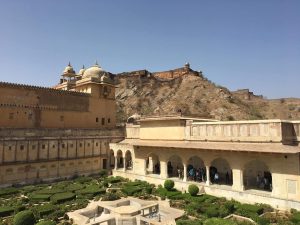 “Important political visit,” grunts the entrance guard when Jiji asked him. Well, that seemed safe enough, so we begin walking towards the world’s largest sundial, when all of a sudden, Hillary Clinton glides through the park entrance, less than 50 feet away from us. Madness and hilarity ensue, as the absurdities of the day begin to catch up with us, and the anciently grand astronomical instruments lay forgotten.
“Important political visit,” grunts the entrance guard when Jiji asked him. Well, that seemed safe enough, so we begin walking towards the world’s largest sundial, when all of a sudden, Hillary Clinton glides through the park entrance, less than 50 feet away from us. Madness and hilarity ensue, as the absurdities of the day begin to catch up with us, and the anciently grand astronomical instruments lay forgotten.
Though our day was far from over, I will end my narrative here, at the pinnacle of our confusion. These types of overwhelming days, where the strange and familiar swirl together in intensely chaotic ways, are the norm, not the exception, on cross-cultural. Responses to days like this vary. Sometimes we laugh; sometimes we cry. Sometimes we ruefully admit to each other, “India wins…again.” Sometimes we lash out in defensive anger. Sometimes we simply shake our head in bewildered wonder. And sometimes, when we don’t know what else to do, we give each other knowing smiles and say, “Jiji.com.”
*We don’t actually know why he was such an advocate for Jiji.com, considering the domain belonged to a Chinese app store, but we are guessing he thought it made him look cool.
-Harrison Horst
Observation of Space – A Compilation of Sporadic and Mismatched Thoughts
Bustling city. Dusty streets full of rickshaws and cyclists, tour buses and zippy little cars. Snack shops spotting the edges with the typical strips of chips and peanuts and assortments of odd Indian Chex-mix of sorts, butter cookies and other couple-of-rupee treats. Stray dogs picking through bits of trash, the occasional cow confidently making its way down the street. A cricket game down a side road drawing in a crowd of young boys and spectators. The chorus of honking.
Arriving in Agra just an hour before, the novelty of a new city drew me out of my hotel room and into the color and chaos of the streets. Because what’s better than a walk after sitting on a bus all morning?
“If we walk down this road for about a mile, we’ll reach the Taj,” my trusty navigator, Abigail, told me. So we turn off the main road down a side street, shifting our gaze from the bustle of the busy street to the sight in front of us, an entirely new type of bustle. The road narrowed, only fitting cycles or small cars, carts or cows among the people walking through. A small school to the right in a block cement building, kids in uniform leaving in little chatty groups, hand-in-hand with a parent or on the front seat of a motorcycle between the arms of a brother or father. Women in bright saris sitting in doorframe, men standing in small clusters on the side of the road.
Meandering down for some time, my eyes never knew quite where to focus. Do I stare back at the wide eyes of the small girl playing in the street, at the young man who turns on the back of the motorcycle until we’re no longer in sight? Do I look at my feet to avoid stepping in piles of manure or look up to avoid the 1,000 kilo cow lumbering towards us with no presumed plan to change its path? Ahh, but how can I not focus on the small pig that suddenly scurries a foot below me in the concrete slab-covered drainage system of the road? Laundry hanging across rooftops, vegetable cart rolling through, steam rising from an open wok.
As the road narrowed and drove us deeper into the heart of life in Agra untouched by tourists and outsiders, our presence became more and more of an anomaly. Retracing our steps, we returned through the commotion of evening activity back towards the chorus of honking, left the ‘village life’ tucked between the blocks of cement buildings and hopped on a rickshaw with the understood one word request, “Taj!”
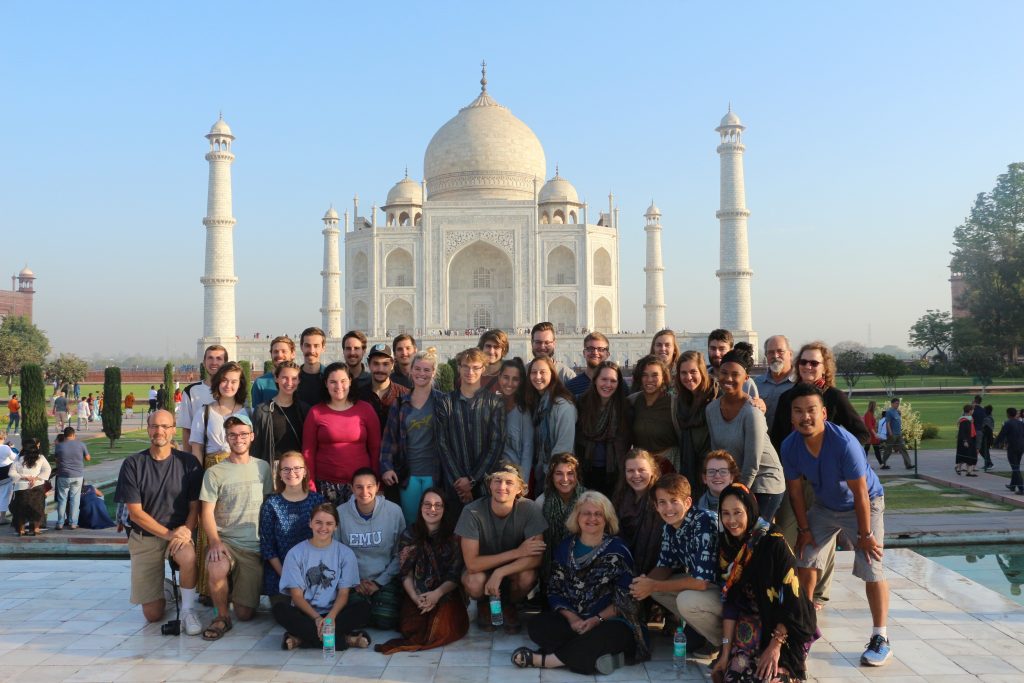 Five minutes later, our rickshaw driver dropped us along the outskirts of the Taj, a paved, well maintained area blocked off to vehicles. We were no longer an anomaly as we walked along the identical, over meant constructed shops filled with all of the Taj trinkets you could ask for – t-shirts, magnets, small replicas, pieces of the marable used for the Taj Mahal itself, caps with its outline stitched on front. The streets full of sunglass-donning, visor-wearing tourists glowing in their sight-seeing-best attire from their recent visit and, no doubt, photoshoot in front of the Taj.
Five minutes later, our rickshaw driver dropped us along the outskirts of the Taj, a paved, well maintained area blocked off to vehicles. We were no longer an anomaly as we walked along the identical, over meant constructed shops filled with all of the Taj trinkets you could ask for – t-shirts, magnets, small replicas, pieces of the marable used for the Taj Mahal itself, caps with its outline stitched on front. The streets full of sunglass-donning, visor-wearing tourists glowing in their sight-seeing-best attire from their recent visit and, no doubt, photoshoot in front of the Taj.
Drifting from the clean, well-swept streets, we found ourselves in a bazaar outside of the Southern gate of the Taj. Congested and chaotic, each step was met with a new smell, a “shopping?,” called in our direction, children rushing to our legs, hands to their lips asking “chocolate?,” rickshaws pulling into our path and a swirl of people and color. After wandering through random streets for some time, a navigational nightmare for poor Abigail but a whirlwind of energy and excitement for us both, the setting sun cued our meandering return to the quiet of the Taj and throngs of hopeful rickshaw drivers. Fifty rupees and a short few minutes later, we made it back to the quiet of our hotel.
The next morning we woke at sunrise, waited in the long line of tourists, got our passes, water bottles and shoe-socks and walked through the main gate of the Taj. As it entered our view, first thoughts included “wow, that’s big,” “wow, that’s small,” “wow, that’s white” and “dang”* coupled with feelings of awe at its magnificence. Inlaid stones and Arabic script embellished with intricacy, striking symmetry, and mosques on either side paying homage to the radiance of its white marble against the blue sky.
Taking the trademark India tourist ‘I’ve been to the Taj’ photos, we spent the rest of the morning admiring this symbol of love, the love of the emperor Shah Jahan for his wife, before returning to the hotel for breakfast.
The beauty of the Taj was spectacular. Mesmerizing. Yet in that space, I was reminded that the magnificence of India does not lie solely in its iconic wonders, but in its energy and noise, bustling streets, the swirl of people, the smells and contrast and color.
After a day of sights, we loaded up and headed to our next destination, Amritsar, redefining what India looks like once again.
-Sylvia Mast
*Thoughts from randomly surveyed group members
Independent travel in Guatemala and Belize
Free travel was supposed to be a well-earned vacation from learning; I was expecting to saunter off into the Guatemalan jungle and render my mind blissfully empty of deep thoughts. Yet, in the aftermath of our week-long adventure through the mountains of Cobán and the steamy lowlands of Lake Izabal, I’ve realized that I accidentally learned a lot:
Lesson 1: Friendship can be found in unexpected places, like at street food stands or in a packed microbús.
Lesson 2: God appears in unexpected places. I’ve seen God in the majesty of hidden jungle waterfalls, in the kindness of generous strangers, and in safe bus rides along dangerous mountain roads. (In the last case, there were moments where I really did wonder if I was about to meet my Maker.)
Lesson 3: “Barriga llena; corazón contento.” (Full belly, contented heart.) Always travel on a full belly, lest you subject your travel companions to the wrath of a hangry heart.
Lesson 4: A pretty place is nice to look at, but true beauty is found in friendship. Thanks to my travel buddies, to our hosts, and to the many, many people who fed us and welcomed us into little-known corners of this incredible country throughout the past week.
-Kat Lehman
-morning boat ride on Lake Izabal-
I could see the curve of the Earth,
smell the immensity of the horizon
with the 6am stubble of mountains
way way way across the way
the water was gently shifting porcelain
warm to the touch
studded with seabirds and floating green gardens
the sky hummed with blues and grays
and the intangible promise of a new day
just over my shoulder the sun peeked
through a crack in the clouds
and it was all yellow
I smiled at our guide, his hand on the tiller,
his bare feet dangling
and his one silver tooth caught a glint
of the rising sun
when he smiled back
and pointed out a small family of monkeys
breakfasting in the coastal trees
Lessons Learned on Free Travel
- You don’t need to have a plan to have fun. Spontaneity=gaiety
- Feed yourself regularly. You can get hangry even if your stomach isn’t registering hunger.
- Take every possible opportunity to fling yourself naked into a body of water.
- Bus rides through Guatemalan countryside are really fun in you don’t mind catching some air.
- Eat every mango you can lay hands on, for who knows when it shall be thy last?
- Donde caben dos, caben tres (o seis o diez). Aka, a bus is never truly full.
- It’s scary to climb a waterfall, but also, once you’ve done it, you’re on top of a waterfall…so, worth it.
- Talk to anyone and everyone. Your Spanish is good enough.
- Travel with people who aren’t afraid to wander slowly and aimlessly because that’s how you stumble upon the best hidden treasures.
- Take in everything with wide eyes and an open mind; don’t be afraid to slow down and marvel.
- Not all chihuahuas suck.
- Sometimes scorpions lurk in backpacks and you have to catch them in your water bottle and stare at them for a while. Do not benevolently release them into the wilderness because they will sneak back into your room and attack you in the middle of the night.
- You can hop in the pickup truck of a total stranger and come out alive. Stranger danger is not always a thing. Trust people.
- Guatemala is a beautiful country filled with wonderful and kind people (but you already knew that).
-Elizabeth Nisly
I have never seen mountains like Guatemala’s before. They breathe green into every corner of my sight and astound me with the steepness of their reaching slopes. I could stare and stare and never get enough of their majesty.
– Megan
Our group of three spent three days in Rio Dulce and three days in Lívingston, choosing to save money and spend less time traveling by staying in Guatemala. Although if you think about it, the money we were given for free travel wasn’t just handed to us – it was originally ours that we used to pay tuition for this semester. Still, it felt like Byron and Lisa were just giving us money to travel.
I can’t write about grand adventures or discoveries, but I can write about what the three of us felt so strongly throughout the week; the restorative power of doing nothing: of sleeping in, of reading novels on a roof or by a pool, of not having scheduled times to eat or sleep or be in Spanish class or to be somewhere. For the first time all semester, except for a few days in Arizona, we had no planned activities, and it was glorious. Combined with the scenery, we could not have asked for a better, more relaxing week out of the city.
-Jenna H., Anali & Nathaniel
We were very thankful that our first two days of travel to Placencia, Belize were not an indication of how the remainder of our free travel would go. Traveling in Guatemala posed more challenges than we would have had while traveling in the United States because we were not able to plan much in advance. We could not look at bus and boat schedules online leading us to always take the earliest bus/boat to make it to our next destination just so that we could sit and wait a long time for the next one to leave. Making it even more difficult, we had to keep track of three different currencies (Quetzales, USD, BZD), two different languages, as well as our group and the other two groups. And, on top of all of that, we had to deal with Guatemalan time. This means that nothing leaves or arrives on schedule and there is no rush.
The most stressful part of our travel was an hour boat ride from Livingston, Guatemala to Punta Gorda, Belize that took up the largest portion of our transportation budget during the middle of a storm. We were sitting in a 20-passenger boat that was open on all sides, and thrown around by the wind and the waves. The torrential rain started when we could no longer see any sign of land. We stopped to refill on gas during this downpour and we were convinced that we were lost. However, we started moving across the open ocean again and finally caught sight of land. The rain stopped, the sea calmed, and we no longer had to huddle under the tarps, praying and holding hands. All of these struggles made the beaches of Placencia more beautiful and enjoyable. 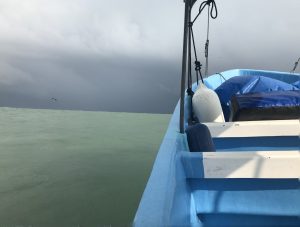
We spent the next 5 days 40 feet from the beach, enjoying the luxuries of air conditioning, warm showers, speaking English, and independence in our food and activities. One of our highlights was eating Tutti Frutti gelato almost every night. We loved the small town feel of Placencia and the ability to walk everywhere. Most of the shops and restaurants were located on the main sidewalk that provided easy access to the beach and the whole town. Despite our traveling difficulties, we all agree that Placencia was well worth it. We would all love to go back another time to experience everything we did not do and to re-experience some of our favorite memories.
-Ginny, Rachel, and Madeline
Our group, like a few others, was lucky enough to explore the beautiful, tropical country of Belize for our free week of travel. From the very first day, our trip went so smoothly it felt too good to be true. We left at an early 2:30am and took a variety of transportation to reach Puerto Barrios, Belize, where we ate pizza and had a relaxing night on the balcony, looking out over the ocean. Throughout our journey to Placencia, Belize, our final destination, we walked, took 3 taxis, 2 boats, and 2 busses. This long journey made Placencia even more enjoyable upon arrival. After getting off the boat, we were all surprised to be welcomed in English, a nice change from the ongoing Spanish we had been hearing and studying in the city. We were greeted by our gracious and hospitable host, Analise, who provided us with a house located right on the lagoon and included a rooftop pool, kayaks, tubes, bikes, and a beautiful lounging area where we spent most of the week. Analise and her boyfriend even cooked us a delicious barbeque meal during our time there.
Placencia is a small lively town located on a peninsula where the tropical air, bright blue oceans, and unique restaurants and bars welcome many tourists from all over the world. Unlike Guatemala and Mexico where we had previously visited, Belize offered a different atmosphere and culture. Placencia provided us with a sense of community, safety, and an overall island vibe that was thrilling to explore. During our time in Placencia, we visited the beach, made our own meals (mostly consisting of pasta), lounged at our pool, and sun-tanned. On the last day, we were able to take a boat out to a secluded island to snorkel! We saw schools of fish, a rainbow squid, and multiple stingrays. We felt so free swimming and scanning the coral reefs that reside under the Belizean blue waters. Until our travel day back, every aspect of our trip was perfect. On the way home, we ran out of gas on our boat, which caused us to miss our bus back to the city. This was quite an experience, but we all made the most of it and embraced the unpredictability of travel. Overall, our trip to Placencia was an unforgettable adventure, and turned out to be the perfect, much-anticipated break we needed.
-Laura, Katie, Clara, Jenna, Seth
During our weeklong adventure throughout Guatemala, we stopped in Semuc Champey for a couple of days. This is one of Guatemala’s most famous and most beautiful national parks, and it is preserved perfectly. It consists of a river flowing into naturally formed pools with a small waterfall cascading into each pool. The water was extremely clear and very refreshing to swim in. But the swim was not without a price, the rocky path to the pools were both sharp and slippery. Somehow, none of us took a spill and despite the danger, the view from the pools was absolutely worth it. From the water, we could see down the river valley into the sunset over a distant mountain range. All in all, it was a fantastic trip full of conversations with interesting people, beautiful scenery and long, long, long bus rides.
-James, Sol, & Lucas
Rajasthan Overview
After our stay at the Sarang Center in southern India, followed by our spring break week, we traveled back to Delhi before heading into northwest India – into the state of Rajasthan. Rajasthan, in Hindi, means “land of kings” and is the ancient home of a collection of forts, palaces, fancy tombs, and Silk Road oases. Our activities during this period included zip lining over the blue city of Jodhpur, riding camels in the Thar desert, staying in a centuries-old merchant hostel (called a haveli), and embarking on an unsuccessful tiger safari. In Rajasthan, history is visceral; it pops out of the cities at you, while at the same time reconciling its colorful past with the complexities of a modernizing future.
“Connection to…”
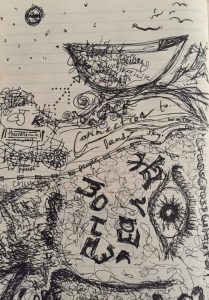
Artist Statement: This drawing/visual processing journal entry was created during our return to Delhi after having traveled through various cities and villages in southern and eastern India. I was processing the connections that I felt in each of these spaces, specifically the connection to the Earth and all that is in it and surrounding it. -Kate Kauffman
Ode to a Displeased Camel
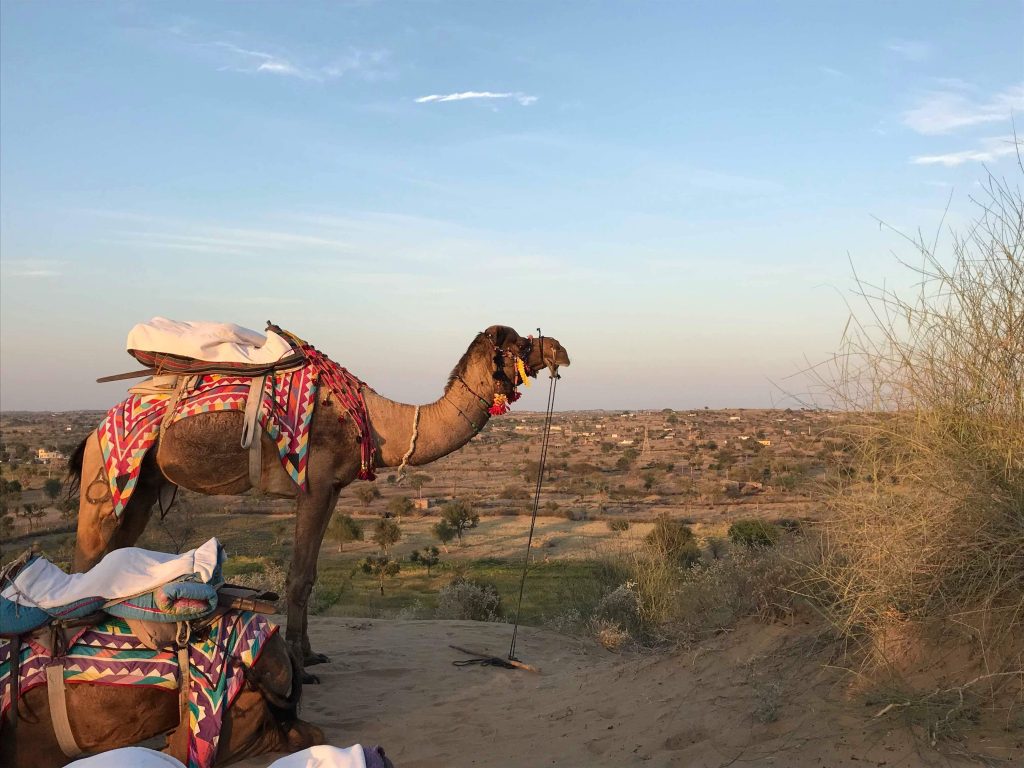
And now, the moment you have all been waiting for… the camel ride.
Sheer terror. Upon greeting camels, one cannot help but marvel at their size, poorly masked ferocity, and similarity to dinosaurs. Evan and I agreed to share a camel, and chose a pretty (looking) one to ride. I decided to sit in the front, and, with the go-ahead from the camel’s trainer, began to mount. The camel immediately roared to life and began staggering to its feet with a burbling shriek and spraying of effervescent foam. I was quickly thrown off, landing with a thud in the sand. Great start! Evan and I agreed it would be wise to choose another camel, and did so – Alex and Emerson claimed our original camel, and six people (allegedly) were necessary to hold the camel down in order for them to mount. The camel Evan and I ended up on was named Bintu, and seemed much more docile than our former beast.

The most terrifying part of camel riding is the camel getting up and down in order for its riders to get on and off; to get up, it first violently extends its back legs, plunging forward forcefully enough to make most riders doubt their ability to stay aboard, quickly followed by the aftershock of the front legs following suit.
Once the camel has gained its footing, the ride becomes somewhat less scary. We set off into the scrubby desert, clutching our camel fairly tightly. I would give a delightful description of our arid surroundings, but was admittedly, at this point, too focused on maintaining my adhesion to my newfound vehicle to marvel at the nearby plant life.
The destination of our ride was the peak of a large hill, from which we were to watch the sunset. This sounded idyllic; however, Evan and I discovered with slight dismay that this meant we would have to thread our way up a thin, sandy path that hugged the side of the hill. On my own feet, this would not have been a daunting task. The magnitude of the task increases quite significantly, however, when one finds themselves about eight feet from the ground on the back of a wheezing beast with an affinity for walking at an angle, it’s front and back legs seeming to lack communication with each other.
Despite our concerns, we reached the summit relatively uneventfully (if such a thing can be said about any camel riding experience). We dismounted in the expected roller-coaster-esque fashion and sat down to saturate ourselves with the waning rays of the evening sun (and perhaps to regain mental composure). I spent the break observing the camels with a mix of amazement and revulsion (they are truly disgusting creatures – the foaming mouths, the prehistoric wailing, the spongy feet… I could go on). They were framed neatly by the sun’s final light, the stately dunes and irrigated fields dotting the landscape. I am undecided as to whether these glorious surroundings spotlighted the horrors of the camels or lent them an odd air of royalty; either way, I certainly have gained a respect for them.
-Joseph Harder
Kerala & Sarang Center
A day in the life at the Sarang Center, second person POV:
6:15 am: First alarm
6:20: Second alarm
6:22: Get out of bed, throw Kalari clothes on
6:31: Take Rickshaw to Kalari
6:47: Arrive, lather oil on body, go through bowing routine
7:01: Smile and grimace after Guru-ji starts class with “Three laps!, one more, one more!”
8:30: leave class a bit more flexible and with the knowledge that you will be feeling this in muscles you didn’t know you had
8:45: Arrive back at the houses, gather breakfast, eat with your 9 housemates by sitting in a circle – on couches, on chairs, on the floor – & talk about each other’s mornings
9:12: Take shower if your gracious housemates are able to fill the water tank
10:00: Violin class! (I’m a complete newbie… God bless our ears)
12:00: nap time.
1:30: lunch. Gather food, sit in circle, discuss the current snack situation.
2:00-7:30: free time! Options include, but are not limited to:
- read
- class assignments

- practice violin
- provide for your family by braving the heat and head to town for snacksonsnackonsnacks
- play with children
- Journal
- Read
- Go for a run in a nearby village & gain new running buddies, usually in the form of curious, lanky adolescents with wide smiles and “hello, where from?”
- Read
- Pass out invitations to neighbors for upcoming program that your group will be putting on
7:30: supper! Eat again with your house, discuss pressing topics such as:
- Is everybody okay with a no-pants rule?
- The restaurant situation in Harrisonburg – McDonald’s or Cuban Burger? Quality or quantity?
- Youth group reminiscences, good and bad
- Who is going to eat the last popper?
- How is percussion going, Trevor?
- “Why EMU needs a frisbee golf course” – a persuasive speech by Trevor Oyer
- Spirit Animals
- State of the Snackage (not to be confused with State Of The Union)
10ish: Set alarm, climb in to bed, and whisper an assuring “yes, we can” to your hamstrings in preparation for the next day of classes
 On a more serious note: Our time at the Sarang Center was, for me, a much needed change of pace after our time in Goa. We lived in houses, interacted with neighbors, and experienced the unpredictability of life in India through tentative schedules and iffy water/electricity availability. It was the first time our living space was truly “off the grid” with no internet/TV within close proximity. It wasn’t rare for me to walk downstairs and see 5-7 people sitting in a circle, reading between classes, or walk outside and see other group members playing badminton or soccer with neighborhood friends. Some houses even went the extra mile, inviting neighbor kids over to paint, play games, and exchange words from respective languages.
On a more serious note: Our time at the Sarang Center was, for me, a much needed change of pace after our time in Goa. We lived in houses, interacted with neighbors, and experienced the unpredictability of life in India through tentative schedules and iffy water/electricity availability. It was the first time our living space was truly “off the grid” with no internet/TV within close proximity. It wasn’t rare for me to walk downstairs and see 5-7 people sitting in a circle, reading between classes, or walk outside and see other group members playing badminton or soccer with neighborhood friends. Some houses even went the extra mile, inviting neighbor kids over to paint, play games, and exchange words from respective languages.
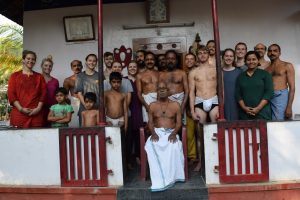 We each got to pick two classes to take for two weeks. Options included Kalari (an Ancient Kerala martial arts form), Carnatic Vocal, percussion, or violin, mural painting, cooking, yoga, and theater. When our time came to an end, we all participated in a program to share what we learned with demonstrations from each class. It was humbling to see familiar faces in the crowd, ranging from faces we would pass on our way to class, local shop owners, and our own gurus.
We each got to pick two classes to take for two weeks. Options included Kalari (an Ancient Kerala martial arts form), Carnatic Vocal, percussion, or violin, mural painting, cooking, yoga, and theater. When our time came to an end, we all participated in a program to share what we learned with demonstrations from each class. It was humbling to see familiar faces in the crowd, ranging from faces we would pass on our way to class, local shop owners, and our own gurus.
I am deeply grateful for the community we were surrounded with for those two weeks, as they developed a home-stay feel for our large group through their hospitality and openness within their own space despite our somewhat invasive and curious presence.
This amount of traveling and level of exposure to so many aspects of India does provide a more well-rounded view of the country, but it can be overwhelming. Time at the Sarang Center gave me an Indian-esque type of stability and “home” in the midst of all the movement on this journey.
-Abigail Shelley
Guatemala: Poetry
Hola m’hija
Ahorita llego
De platicar con un ciego
Pero voz fijo
Su corazón de fuego
Perdió su visión
En el año ochenta y siete
Por un accidente de cohete
Creando una fisión
En ambos ojos y la mente
Escuchame, me indicaba
Es el trigésimo primer año
De vivir así cotidiano
Pero lo que me perjudica
No es aquel daño
Lo que más me ha dañado
En estos treinta y un años
Es que cada ser humano
A quien he escuchado
Le toma la visión por sentado
-Adam Moyer
Dirt floor and hanging corn
Lush carpet and ceiling fan
Candle light and wood fire
Flipped switch and microwave
Wooden bed and shared room
Mattress pad and closed door
Tortilla making and mountain climbing
Eating out and five cars
Eight siblings and roaming chickens
Nuclear family and backyard
Outhouse and outdoor spigot
Flushing toilets and hot water
Playing catch and manual labor
Toy room and studying science
Worn clothing and no education
Full closet and college degree
Below poverty and pure joy
Middle class and …
-Madeline Mast
Poems are freaking hard
Harder than living abroad
We’re already halfway done
Time flies when you’re having fun
There was AP, Douglas and Tucson
Guatemala City and Coban
And I almost forgot Atitlan
My Spanish still sucks
But who gives two ducks
(I write kid friendly poems)
I have experienced so many cultures
And seen the basurero with vultures
I have slept on planks of wood
And where people were massacred I have stood
The people here have beautiful souls
They’ll keep giving you food when you’re full
While they eat so little
And have so little
The lucky ones have opportunity
And the rest live in poverty
Yet they all wave and smile
While this gringo says “buenos” and passes by
-Lucas Miller
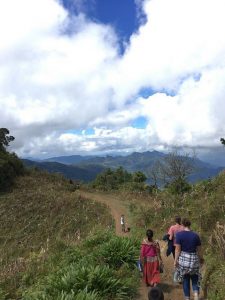 Where is the oxygen
Where is the oxygen
Not in my lungs
My throat burns
Straining my legs
My back
My whole being
These children
We would label them poor
And yet here
In this context
I’m the poor one
Lacking strong lungs
Legs that don’t ache
When I pull myself
Up the mountain
Where is my knowledge
Of using this bathroom
And sleeping on wood
I am poor
I have nothing
That is useful here
In this context
I am forced to think
A different way
For to me they’ve
Always
Been poor
Because poor is just
About money
But being here
My money means
Nothing
And poor is about lack of
Knowledge and
Ability
And language
-Jenna Heise
India: Beauty, Colonization and Wrestling with Enough
Goa Reflection
The state of Goa is located in western India with its coastline stretching along the Arabian Sea. Its history, like much of India’s history, involves European colonization. The Portuguese set their eyes on Goa when realizing its valuable placement geographically as a port for spice trading along the Arabian Sea. In the late 1500’s the Portuguese took over the state of Goa and controlled it until 1961 when Goa became independent from Portugal and became officially a part of India again. What remained was a unique convergence of two cultures that has continued to develop into what Goa is today.
Finding Portuguese culture in Goa, and India in general, was a surprise for me. During our two 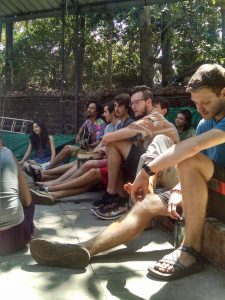 weeks in Goa, I continually found myself astounded by the interconnectedness of culture through art, music, religion and architecture. Colonization, however, has deeply influenced the culture and I started becoming critical of what we were seeing, hearing and being exposed to. I was at times uncomfortable hearing how beautiful and unique Goa is because of Portuguese influences and not hearing much of the negative impacts of that influence. I struggled with knowing that colonization in the world has been forceful dominance of one group/culture over another, but also loving the Portuguese influenced art, music and architecture I was seeing. It seems that Goans have adopted and claimed this mixture of culture as their own, nonetheless I felt as if our exposure was unbalanced and catered to us as westerners only wanting to see/learn the “positive”, “easy” things. I expected to learn more about the harm and abuse of power that the Portuguese brought upon the region. It was incredible seeing Portuguese and Indian culture existing in the same space because I have never been exposed to that dynamic before.
weeks in Goa, I continually found myself astounded by the interconnectedness of culture through art, music, religion and architecture. Colonization, however, has deeply influenced the culture and I started becoming critical of what we were seeing, hearing and being exposed to. I was at times uncomfortable hearing how beautiful and unique Goa is because of Portuguese influences and not hearing much of the negative impacts of that influence. I struggled with knowing that colonization in the world has been forceful dominance of one group/culture over another, but also loving the Portuguese influenced art, music and architecture I was seeing. It seems that Goans have adopted and claimed this mixture of culture as their own, nonetheless I felt as if our exposure was unbalanced and catered to us as westerners only wanting to see/learn the “positive”, “easy” things. I expected to learn more about the harm and abuse of power that the Portuguese brought upon the region. It was incredible seeing Portuguese and Indian culture existing in the same space because I have never been exposed to that dynamic before.
However, I found myself being critical of my biases towards what is beautiful and how my perspectives as a westerner influence my experience here. Did I find Goa so beautiful and interesting because it was a more culturally familiar, comfortable space, or because of observing the differences unique to Goan culture that I had never 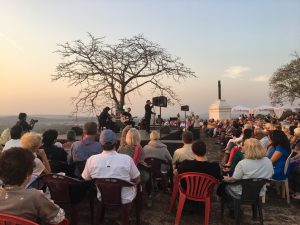 been exposed to before? I believe it is important to be critical of our western lens while we are here, and how it affects our experience here in India. Our two weeks in Goa encouraged me to think about how I am interacting and existing in these spaces and reminded me to keep questioning why I feel emotions such as discomfort or guilt. It reminded me to always be aware of the multiple parts to every story, even if you are only being exposed to one side. There is beauty within the remains of colonization – but that does not mean we should ever be content with that, and forget to ask more critical questions that explain the other parts of the story.
been exposed to before? I believe it is important to be critical of our western lens while we are here, and how it affects our experience here in India. Our two weeks in Goa encouraged me to think about how I am interacting and existing in these spaces and reminded me to keep questioning why I feel emotions such as discomfort or guilt. It reminded me to always be aware of the multiple parts to every story, even if you are only being exposed to one side. There is beauty within the remains of colonization – but that does not mean we should ever be content with that, and forget to ask more critical questions that explain the other parts of the story.
– Emma Petersheim
What does it mean to have enough to live?
To answer this question, it is necessary to define what having “enough to live” means. There is an obvious scientific definition of having “enough to live,” which focuses on the resources a human being needs to survive: food, water, and shelter from the elements. This scientific definition, however, is not sufficient to answer the question in context; in context, the question addresses the inherent differences between cultures as to how having “enough to live” is defined.
To answer this question in context, it is necessary to recognize and analyze the various living standard expectations individuals in different cultures have. In an American context, having “enough to live” is generally equated with some version of the “American Dream” – life in a comfortable suburb with two cars, a few kids, and more than enough money and resources to get by. Though this certainly is not considered the minimum standard of living for all Americans, it is a quality of life the majority of Americans expect.
Americans must realize this lifestyle is one of excess, and that it disadvantages marginalized communities across the world. This lifestyle allocates a disproportionate amount of resources to Americans, meaning people in the US get way more than their fair share of global resources, ranging from food to clothing to oil. Access to more resources inevitably leads to more waste production, which explains why the average American produces more than ten times the daily waste of the average Indian. This is all to say that though Americans tend to view their lifestyles as justified, or even “natural,” from an environmental perspective, these lifestyles are unsustainable.
Now, I do not want to make it seem like I think I do not engage in a lifestyle of excess; I certainly do, as this lifestyle is difficult to avoid while being raised in a society that encourages, and even expects people to have significantly more than they need. This brings me to the main issue I have been struggling with this trip: trying to justify my lifestyle of excess while being surrounded by the people who are negatively affected by my lifestyle choices. The way I see it, there are only a certain amount of resources to go around in the world. Though I am not directly choosing to take those resources away from the people of India, the fact that I do have significantly more than I need to live means I am indirectly taking resources away from people who need them more than I do.
What I am struggling with even more is the fact that despite knowing how harmful my lifestyle is to other people, I don’t see myself changing it significantly when I get back to the US. I am going to justify this by making claims of the difficulty that comes from being counter-cultural, especially when it comes to the American ideals of consumerism and materialism, but realistically, that is nothing more than a poor excuse.
So what does this all have to do with what it means to have enough to live? I think it shows just how privileged we are as Americans to be able to include so many excess items and luxuries in the category of what is “necessary” for survival.
In India, it is obvious that most cannot expect to have the same living standards that many Americans have. The first couple of weeks on this trip, we spent almost all of our time in big cities. In these cities, it became abundantly clear how little many people had. By American standards, these people did not have “enough to live,” as they often did not have more than the clothes on their back and a few other personal items.
However, I do not think it is fair to say the majority of people in these Indian cities do not have “enough to live;” sure, by American standards these people have essentially nothing, but American standards are not universal and should not be used universally. I do not know enough about India to claim I understand how a typical Indian would define what qualifies as “enough to live,” but I do know enough about India to say confidently, an Indian’s definition differs from an American’s.
This is all to say that what constitutes “enough to live” varies from region to region, country to county, and continent to continent. It is important to recognize this for a couple of reasons. Firstly, we must realize our standards of living in the US are not normal as compared to the rest of the world. We should appreciate the fact that we have the ability to live the way we do, while also attempting to alter our unsustainable lifestyles in an effort to promote environmental sustainability and global equality. Secondly, it is important to recognize the differences in living standard expectations across the world because it can become easy for Americans traveling abroad to pity people who do not have as much as they do in an almost imperialistic way. Working to help people who are less fortunate than we are is extremely important, but ideally, this desire to help should come from the right mindset. If we want to help less fortunate people because we recognize their humanity and want the world to be a more equal place, I have no issue with that. If we want to help less fortunate people because we view ourselves as inherently superior, and project our ability to aid them as a sign of racial, social, or political dominance, we are no better than those who used a similar sense of dominance to justify colonizing and abusing people all over the globe for centuries.
In short, what it means to have “enough to live” varies drastically from culture to culture. My time in India so far has made me realize I want to do something about the inequality that derives from those different standards, as I think it is unfair for someone to have too much, or too little, based purely on geographic location of birth. Global economic inequality is one of the modern world’s biggest political, social, and cultural issues, and I believe one of its best solutions is to convince Americans, myself included, that our way of life is inherently unsustainable and marginalizes a huge portion of the world’s population.
-Evan Davis
Guatemala: Alta Verapaz
We’re back from five breathtaking days in Guatemala’s Alta Verapaz, where we stayed with the organization Community Cloud Forest Conservation, led Rob and Tara Cahill, along with teachers and staff from the surrounding Q’eqchi’ communities. CCFC is working with the conservation of the rapidly diminishing cloud forest, as it intersects with the lives and well-being of the people who live there. The work of this organization is far-reaching. There are two main community programs: Kids and Birds, which is a summer-camp-style environmental education experience for children, and Women in Agroecology Leadership for Conservation (WALC). Through WALC, young women learn life skills and leadership, but also plant agroforestry plots, as an alternative form of agriculture that both repairs degraded forest areas and can be a source of nutritionally dense food. CCFC is addressing both social and environmental issues holistically, and coming up with some wonderfully creative solutions.
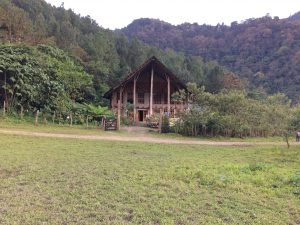
During our five days in the cloud forest, we spent three nights in the CCFC facilities, which are filled with windows, light, and wood. The facility was built with careful attention to resource conservation. We got to experience composting toilets, showers heated in pipes that ran through wood cook stoves, and meals featuring ingredients like cloud forest spinach. It felt like there was no boundary between “indoors” and “outdoors.” We got to spend a lot of time outside in the cloud forest. We hiked through the forest two different days, both times reaching caves that were historically places of Mayan worship.
Our other two nights were spent with host families, which we all agreed was one of the most difficult things we’ve done so far on this cross-cultural. We were living in houses perched on the edges of the mountains, in the community of Sebob. While there, we ate meals cooked around a fire, interacted with the intergenerational families who were hosting us, and played a lot of soccer. We wheezed up steep hills (our host siblings nonchalantly sprinting ahead of us), slept on boards, bundled in all of the clothes we’d packed, and tried our best not to cough as billows of smoke from cooking fires hit our faces. Even in writing that, I am cringing a little bit. We all know how incredibly privileged we were to be there, how hospitable our host families were, how little we have to complain about in our daily lives. As we walked down that mountain for the last time, I wrestled with feelings of guilt at the bit of relief I felt at returning to the CCFC buildings, with their hot showers and soft beds. These mixed feelings of gratitude and guilt linger with me, as I return to life at school in the city.
That week gave me a lot to think about in regards to how we talk about conservation and issues of environmental stewardship, since this is one of CCFC’s main areas of focus. Because I am an Environmental Sustainability major at EMU, I was particularly interested in seeing the intersection of culture and environment from an angle other than that of the United States. Our relationship with the environment, and how we respond to environmental degradation, are so dependent on where we were born, who our families are, and what our surrounding culture says about environmental stewardship. I saw a lot of similarities between the U.S. and Guatemala in our environmental concerns: the ways that so many of us take for granted our natural resources, our rapidly dwindling forests, climate change as a life-altering force in all of our lives, the cultural significance of agriculture. Continue reading
